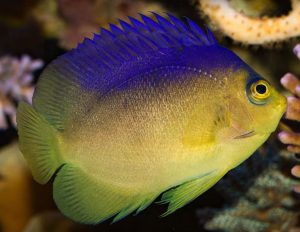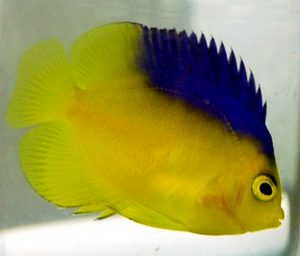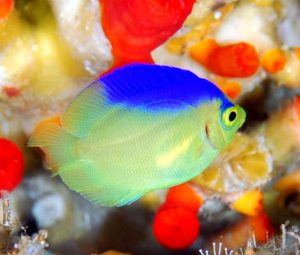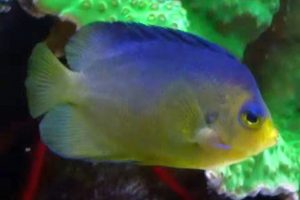The Blue Back Angelfish (Centropyge colini) known to tropical fish keeping enthusiasts as Colin’s Pygmy Angelfish, Colin’s Angelfish, and Cocos-Keeling Angelfish is a rare, shy, deepwater, pygmy angelfish found from Indonesia in the Western Pacific, to Fiji in the South Pacific.
The Blue Back Angelfish is a very shy, rarely seen species that is usually found alone, in pairs, or in harems of 3 to 6 individuals hanging upside down in caves, crevices, and steep walls at depths between 60, to over 300 feet. They seem to be scattered throughout the Pacific and eastern Indian Ocean including; Papua new Guinea, the Solomon Islands, Fiji, Palau, Guam, Marshall Islands, the Philippines, north to Ogasawara Islands and Cocos-Keeling, south of Java. The first specimen was collected in the Coos-Keeling Islands in the late 70s.
Colin’s Pygmy Angelfish has a predominately bright yellow body with a large blue to purple colored saddle like area on the back and spiny part of the dorsal fin, and a blue ring around the eye.
Males are slightly larger than females and are indistinguishable by color, but like most other Centropyge species, Centropyge colini start their adult life as females. Over time, the larger and more dominant individual in a small group or harem will change sex; sometimes within a few days, up to a couple of weeks to become a male.
The Blue Back Angelfish looks similar to the Purplemask or Venusta Angelfish (Centropyge venusta) from the West Pacific. Both have the bright lemon yellow body color with blue to purple above; but the blue in the Purplemask Angelfish extends into the tail fin and the yellow extends upward to just behind the eye to break up the blue with a triangular band.
Centropyge joculator (Coco’s Pygmy Angelfish or Yellowhead Angelfish) was discovered at the same time and location as the Blue Back Angelfish and often share the same deepwater habitat. Centropyge joculator is yellow in front, blue on the back, and has a yellow caudal fin.
In the wild, divers frequently find Blue Back Angelfish (Centropyge colini) sharing their deepwater overhangs and caves with Multibarred Angelfish (Paracentropyge multifasciata), Regal Angelfish (Pygoplites diacanthus) and Yellowhead Angelfish (Centropyge joculator).
Blue Back Angelfish are difficult to maintain in an aquarium environment. A single specimen requires a well established deepwater reef aquarium of at least 70 gallon capacity with a large amount of live rock arranged into plenty of nooks, crannies, caves, and overhangs for them to hide among when they feel threatened. They require plenty of natural foods growing on the live rock, dim lighting to replicate their deepwater cave environment, cooler water temperatures (which means that an aquarium chiller is mandatory) and pristine water quality, which means frequent water changes.
Colin’s Angelfish are rather delicate and although they can be housed in a fish only aquarium with other peaceful species like chromis,
wrasses, etc. they do best in a reef tank setting, however; like other pygmy angels, they may nip at stony coral polyps, zoanthids and clam mantles.
The majority of Blue Back Angelfish will not usually bother noxious soft corals, sea anemones or mushrooms, and in many cases gorgonians, polyps, and green star polyps, but each individual has it’s own personality.
The Blue Back Angelfish has been bred in a laboratory in Oahu Island, Hawaii. They are pelagic spawners that in their natural habitat form pairs or have small harems of 3 to 7 individuals. Males will spawn with individual females usually at dusk. The pair rises up into the water column where the male encourages the female to release her eggs. The pair join belly to belly where both release their eggs and sperm into the water column. The eggs rise to the surface and become part of the plankton chain and receive no parental care.
The larvae raised in Hawaii were fed cyclopeeze and marine algae rich crushed flake foodss, micropellets, and artemia nauplii.
Blue Back Angelfish are omnivores that need substantial quantities of mature live rock in their tank to graze upon in addition to a variety of fresh and frozen Mysis shrimp, brine shrimp, Krill
, Cyclops, meaty crustaceans like clams or shrimp, and commercially prepared foods enriched with marine algae,sponges, and spirulina
.
They do well on frozen Angel Formula and Formula II once acclimated and should be fed at least 2 to 3 times daily. The challenge to maintaining this species is getting it acclimated and then keeping it interested in food. Keep the lighting low during feeding sessions to avoid startling the fish.
The Colin’s Angelfish or Blue Back Angelfish (Centropyge colini) occasionally makes its way into the hobby and becomes available to tropical fish keeping enthusiasts at high prices. The 2 to 3 specimens that appear per month sell at around $500.00 per individual, almost immediately. Avoid purchasing them from exporters in the Philippines or Indonesia unless you have a guarantee that the fish are hand caught. Both countries still allow the use of cyanide fishing methods.
Minimum Tank Size: 70 gallons
Aquarium Type: Deepwater Reef
Care Level: Difficult
Temperament: Peaceful
Aquarium Hardiness: Difficult to acclimate
Water Conditions: 76-78°F, dKH 8 to 12 , pH 8.1 – 8.4, sg 1.023-1.025
Max. Size: 3.5″
Color Form: Blue, Yellow
Diet: Omnivore
Compatibility: Reef w/Caution
Origin: Western Pacific to Fiji
Family: Pomacanthidae
Lifespan: 5-7 years
Aquarist Experience Level: Expert






One Response to “Blue Back Angelfish (Centropyge colini)”
Trackbacks/Pingbacks
[…] Narcosis Angelfish is closely related to Colin’s Angelfish (Centropyge colini) in form and behavior, and is found singly or in small groups at depths from 360 to over 420 […]